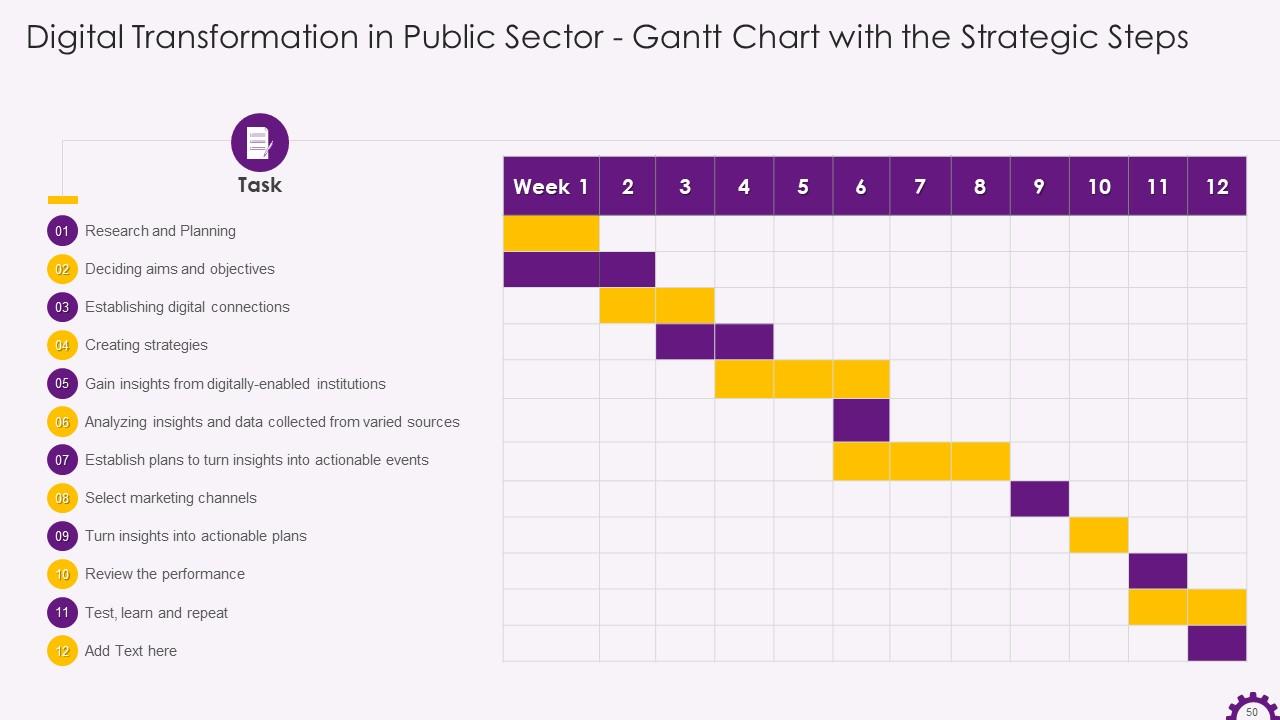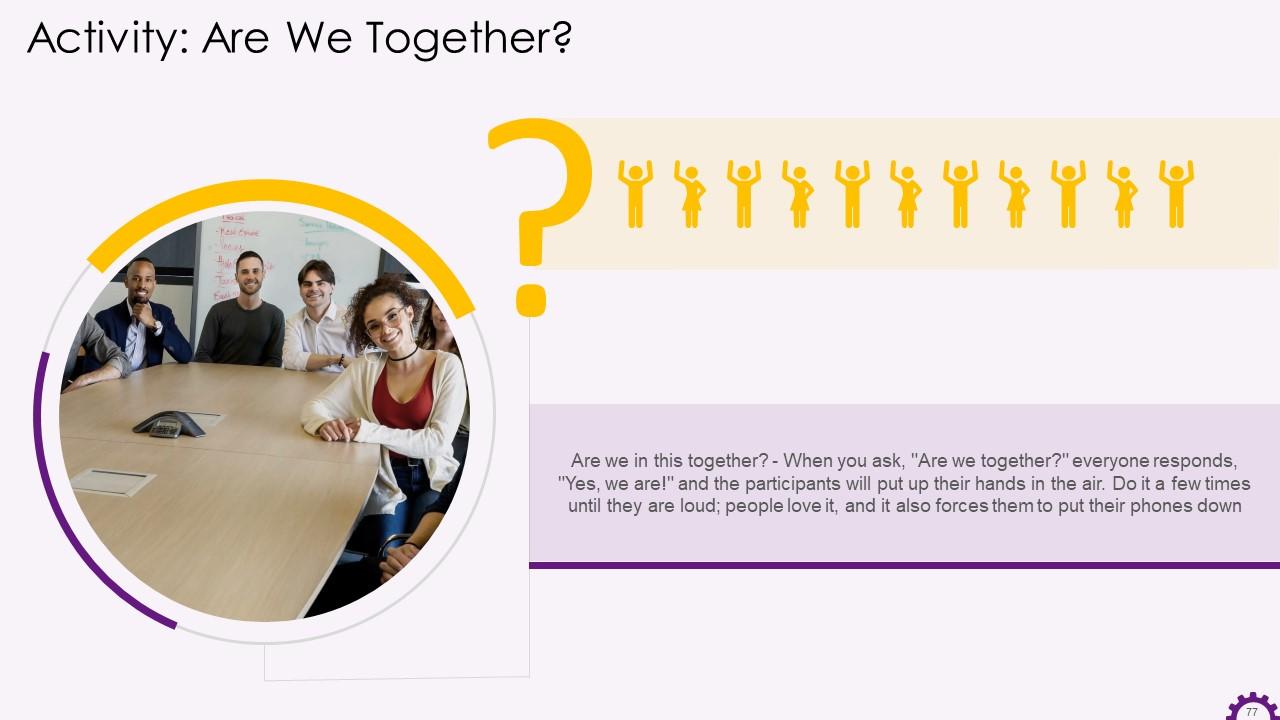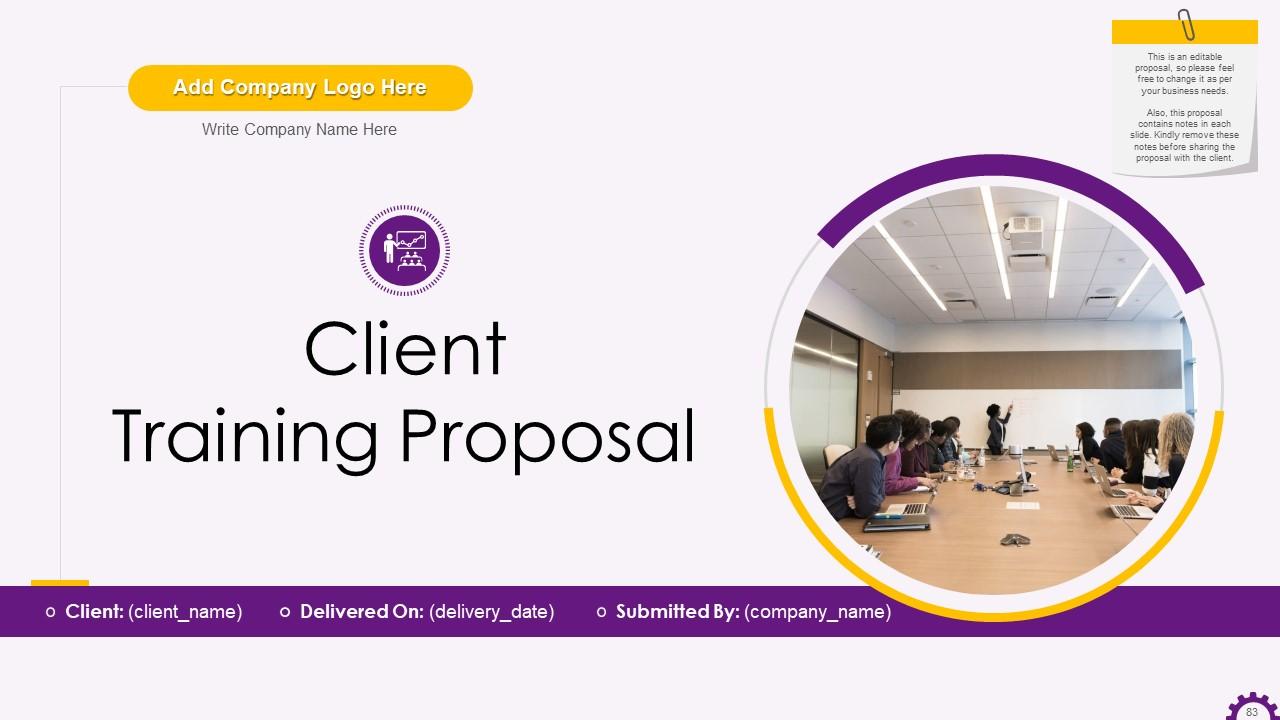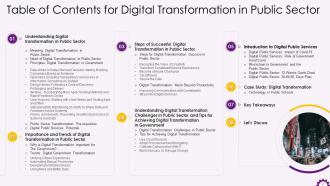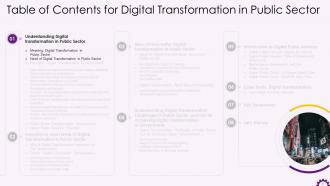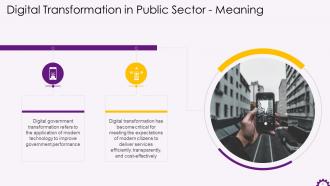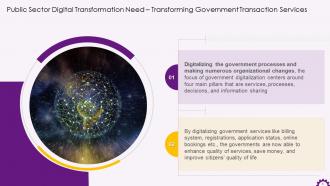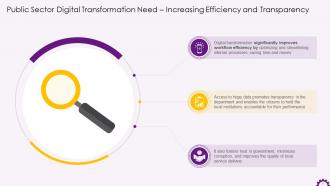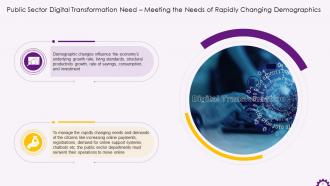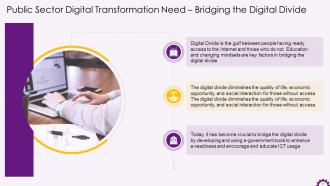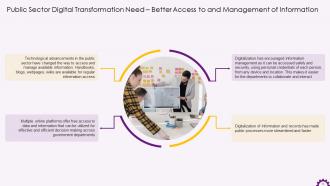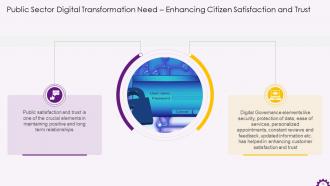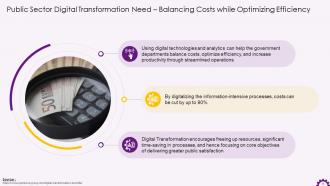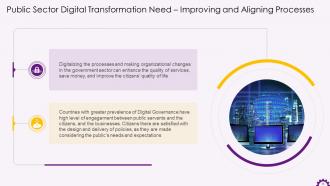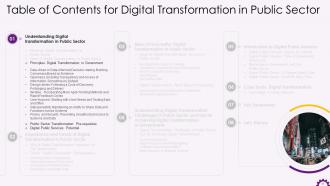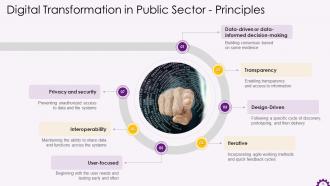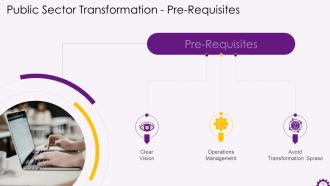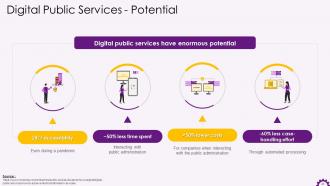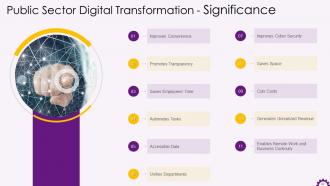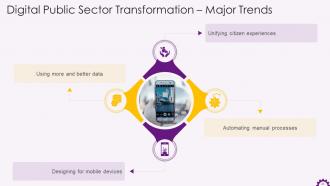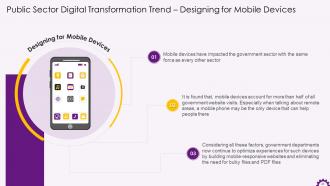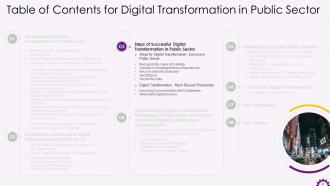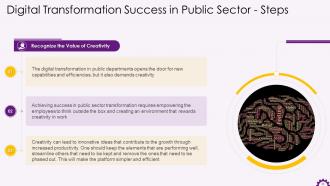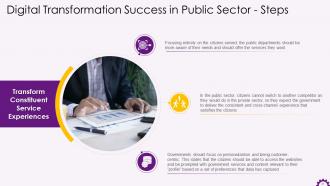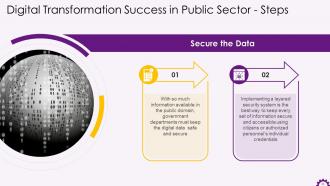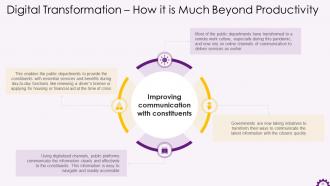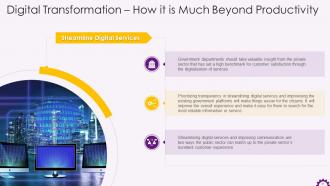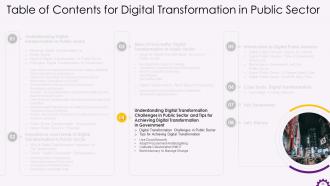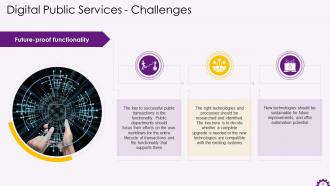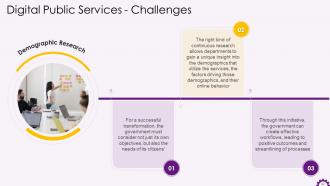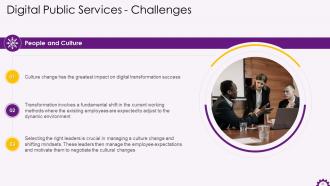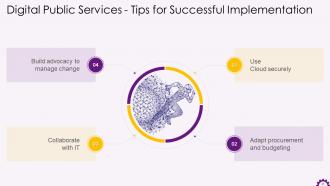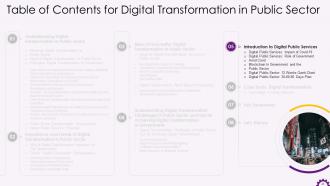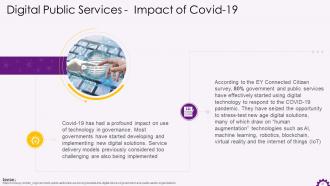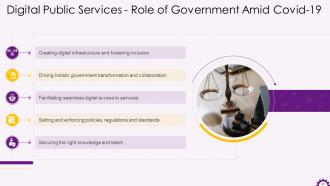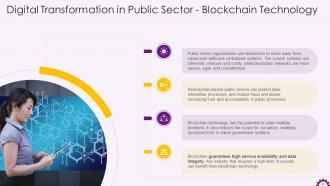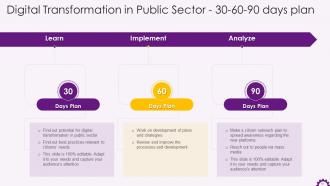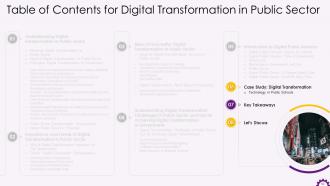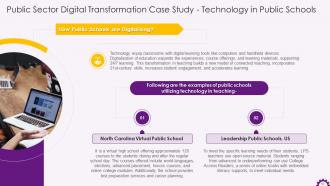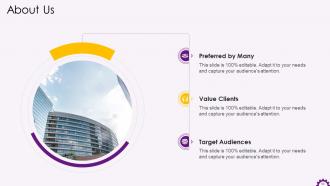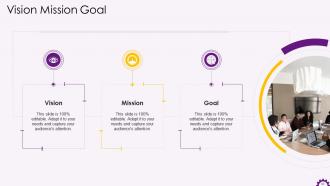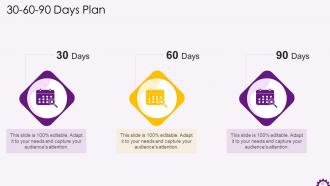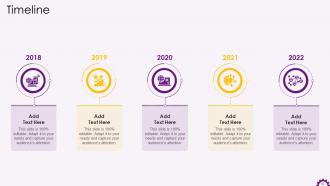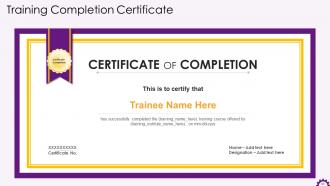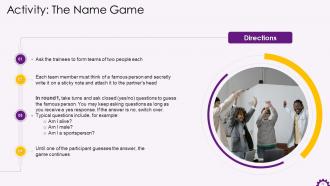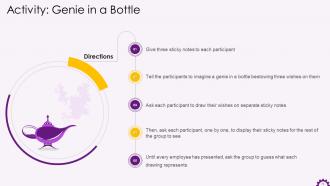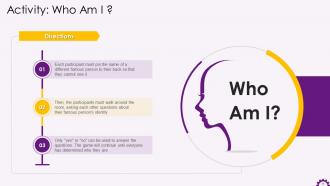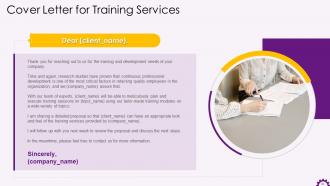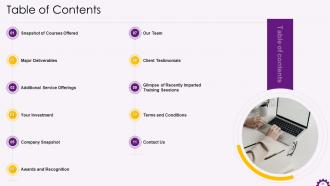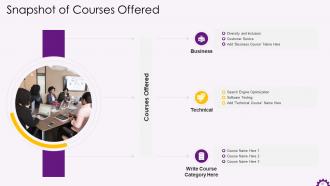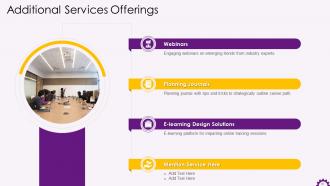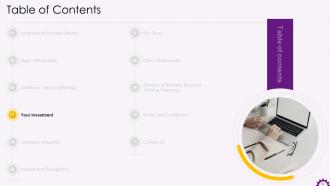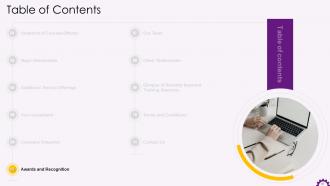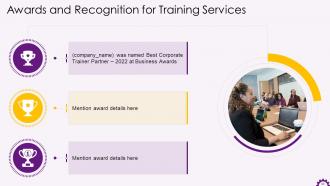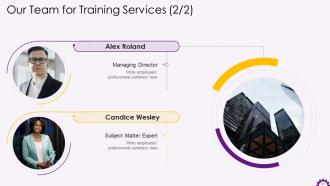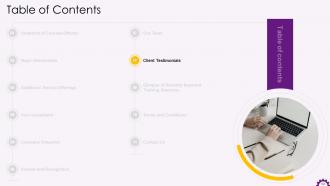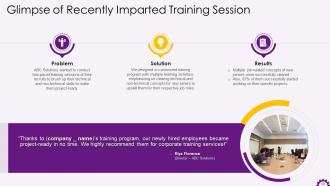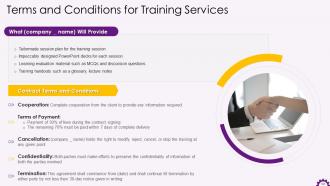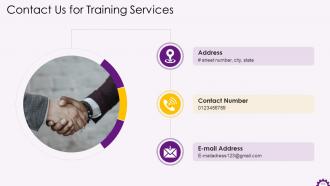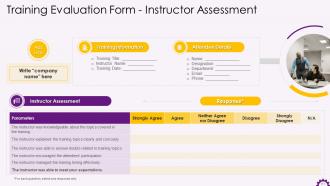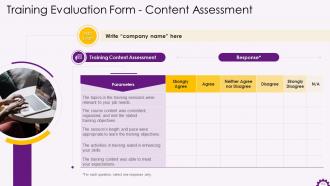Digital Transformation in Public Sector Training ppt
The PowerPoint training deck in-depth covers the digital transformation of the public sector. It covers the need and principles of digital transformation in government institutions, such as transparency and access to information, user-focused, and interoperability. It also covers the recent digital trends in the public sector, such as unifying citizen experiences, automating manual processes, and using data for decision-making. The PPT module includes steps and challenges to successful digital transformation in the public sector. It also contains recommendations for digitalizing of government departments, such as using the cloud securely, cultivating collaboration with IT, and building advocacy to manage change along with digital services offered by the government. The Digital Transformation PPT deck also has case studies and discussion questions to make the training session interactive. Further, it also contains about us, vision, mission, goal, 12 weeks Gantt chart, 30-60-90 days plan, timeline, roadmap, training completion certificate, energizer activities, client training proposal, and assessment form.
You must be logged in to download this presentation.
 Impress your
Impress your audience
Editable
of Time
PowerPoint presentation slides
Presenting Training Deck on Digital Transformation in Public Sector. This presentation deck contains 113 well researched and uniquely designed slides. These slides are 100 percent made in PowerPoint and are compatible with all screen types and monitors. They also support Google Slides. Premium Customer Support available. Suitable for use by managers, employees and organizations. These slides are easily customizable. You can edit the color, text, icon and font size to suit your requirements.
People who downloaded this PowerPoint presentation also viewed the following :
Content of this Powerpoint Presentation
Slide 4
This slide explains the meaning of digital transformation in the public sector. It states that digital transformation is essential for meeting the expectations of modern citizens to deliver services efficiently, transparently, and cost-effectively.
Slide 5
This slide mentions the need for digital transformation in the public sector. Digital Transformation is required for transforming government transaction services, increasing efficiency and transparency, promoting smart government and smart cities, and meeting the needs of rapidly changing demographics. Such transformation helps in attracting new investors, bridging the digital divide. Its aim is also to lead to a data-driven government, better access to and management of information, enhancing citizen satisfaction and trust, balancing costs while optimizing efficiency, and improving and aligning processes.
Slide 6
This slide explains how public sector transformation helps the government enhance the quality of services and citizens' life. Digitalization of various government services like online billings, bookings, registrations, etc., helps improve the quality of public services, and cut costs.
Slide 7
This slide explains how public sector transformation helps increase the department's efficiency and promotes transparency. Digital transformation of the public sector significantly improves workflow efficiency by optimizing processes. Streamlining of the internal processes contributes to saving time and money. Access to huge data, digitally, promotes transparency in an organization fostering trust in government and improving the quality of services delivered.
Slide 8
This slide explains how public sector transformation helps promote the smart government and cities by enabling modern technology. The significant change in government departments has encouraged the public sector to use data and the latest technology to bring efficiency in operations, contribute to economic development, improve sustainability, and enhance the citizens' quality of life living and working in the city. The technological transformations must contribute to citizens' problems, offering them relevant solutions for the same.
Slide 9
This slide explains how public sector transformation contributes to meeting the needs of rapidly changing demographics. Demographic changes like changes in income levels, population rate, etc., can influence the growth rate of an economy, standard of living, productivity rate, savings and consumptions levels. To manage the rapidly changing tastes and preferences of the public, resulting from changing demographics, the public departments should reinvent their operations, focusing more on digital services rather than offline services.
Slide 10
This slide explains how public sector transformation helps in attracting new investors. It states that digital platforms create a highly engaging platform for the investors, encouraging them to align with the requirements of the public and simplify the processes. Investors prefer a department with simplified administrative procedures to make their work easy and efficient.
Slide 11
This slide explains how public sector transformation helps governments bridge the digital divide. Not every person has internet access, and the digital widens. This divide diminishes the quality of life and economic opportunity for those without access, making them feel aloof. Hence, the government should consider measures like developing e-government tools, ICT usage, etc., to bridge this divide.
Slide 12
This slide explains how public sector transformation helps promote data-driven processes and government. It states that data interpretation and critical thinking are a base for better decision-making in the public departments and contribute to introducing new policies and strategies based on analytics and insights. Data-driven governance helps the public departments take scientific decisions with the backing of reliable data.
Slide 13
This slide explains how public sector transformation provides better access to public information and improves available data management. Digitalization of information and records has made the public processes more streamlined and quicker. It has also enabled safe and secure access to information from any device or location, making it easy for the government to collaborate and interact. Public sector's technological advancements have changed the way to access and manage the information available. Handbooks, blogs, webpages are made available to the public for regular information access.
Slide 14
This slide explains how public sector transformation enhances citizen satisfaction and trust. It states that various elements of digital governance like security, protection of data, ease of services, personalized appointments, constant reviews and feedback, updated information, etc., helps in improving customer satisfaction and trust.
Slide 15
This slide explains how public sector transformation utilizes digital technology to balance the costs while maintaining efficiency in operations. Slicker and streamlined operations help balance costs, optimize operations, and increase productivity. Digitalization of processes can help in cost-cutting and encourages significant time saving with a focus on core objectives of delivering greater public satisfaction.
Slide 16
This slide explains how public sector transformation improves and aligns processes by digitalizing and making a few organizational changes. Transformation in public processes and redesigning services considering the public’s needs and expectations enhances the quality of public services and help save money and improve the public’s quality of life.
Slide 18
This slide illustrates various principles followed in the digital transformation of the government sector. The principles are data-driven or data-informed decision-making, transparency, design-driven, iterative, user-focused, interoperability, and privacy and security.
Slide 19
This slide mentions the pre-requisites like clear vision, operations management, and avoidance of transparency sprawl while digitally transforming the government sector.
Instructor's Notes:
- Clear Vision: Any department willing to go through the transformation must have a clear vision, clear reason, and motivation. The motivation can be better services to the citizens, reduction in cost, etc.
- Operations Management: Transformations are essential, but it is equally important to manage and plan them in a way that does not affect the delivery of day-to-day services. Planning the transformation in measurable chunks, empowering frontline staff, communicating powerfully, championing your transformation, and defining strategies and decision-making responsibilities are essential
- Avoid Transformation Sprawl: The leadership should focus on one transformation at a time, or it should be very selective in choosing which transformational efforts can be undertaken simultaneously without confusing everyone. If the focus shifts from the core concept, it may complicate lives of the transformation team and lose credibility with the most crucial stakeholder: citizens. Haphazard Transformation is likely to result in a loss of credibility between the administration and the people, etc.
Slide 20
This slide mentions the statistics showing the potential of digital public services. It illustrates that digital transformation in public services has enormous potential to reduce the time spent by 50%, reduce costs, minimize handling cost and efforts, and offer 24/7 accessibility during normal and even extreme situations like a pandemic.
Slide 22
This slide explains the importance of digital transformation for the government. Digital transformation offers increased convenience, promote transparency, save employees time, automate tasks, access data quickly, unify department, improve cyber security, launch new technology, cut costs, generate unrealized revenue, save space, help in the digital transformation journey and enables remote work and business continuity.
Slide 23
This slide mentions the significant trends followed in digital government transformation. The government departments are now unifying citizen experiences, automating manual processes, services and payment methods for mobile devices, and using better data to optimize and improve their services.
Slide 24
This slide illustrates the importance of a unified citizen experience in the public sector. It mentions that under a unified citizen experience, multiple government services can be accessed online and in one place. A unified citizen experience results in more online engagement and an increasing number of online transactions, making the processes and government transactions simpler for citizens.
Slide 25
This slide mentions how automated manual processes contribute to the growth of public sector services. With automated manual processes, the government can reduce the transaction time from weeks to hours. Automation helps reduce cost, increase accuracy, increase consistency, promote data-driven decision-making, and improve efficiency as it involves less manual labor, fewer manual data entries, fewer remedial hours, etc.
Slide 26
This slide explains the importance of designing for mobile devices in public sector transformation. It states that mobile devices have impacted the government sector with the same force as every other sector, and it may be the only way to reach the public in remote areas. Government departments are now optimizing experiences for such devices from building mobile-responsive websites for the public and improving customer service.
Slide 27
This slide mentions the significance of using more and better data in public services. It states that using real-time data encourages taking valuable decisions as data delivers context and feedback that helps the government become more efficient and more responsive to the wants and needs of the citizens.
Slide 29
This slide illustrates various steps that are crucial in the success of public digital transformation. The steps include recognizing the value of creativity, transforming constituent service experience, becoming a mobile champion, getting efficient, and securing the content.
Slide 30
This slide explains the first step to be followed while making a successful digital transformation experience. It states that creativity should be recognized in digitalizing public services as it opens the door for multiple capabilities and efficiencies. Thinking outside the box and encouraging an environment that rewards creativity should be the primary task for success in public sector transformation. Creativity in services can boost the growth rate and increase productivity.
Slide 31
This slide mentions why transforming constituent service experiences is essential for digital transformation success. It states that in the public sector, the citizens cannot switch to another competitor as they would in the private sector, so they expect the government to deliver a consistent and cross-channel experience that satisfies them. It also mentions that the public sector should focus on personalizing services and being customer-centric to provide a satisfactory customer experience to citizens.
Slide 32
This slide explains the significance of becoming a mobile champion for public sector transformation. It mentions that the increased and growing use of smartphones has transformed the ways in digitalization of services. The public sector has now started responding accordingly with mobile based applications and websites that act as effective communication tools for all citizens. Mobile solutions are considered beneficial for both the government and the citizens in simplification of public processes and saving time.
Slide 33
This slide mentions the importance of being efficient in public sector transformation. It states that digitalized processes in public sector become more streamlined, engaging and efficient when connected to latest technologies like Cloud, eSignatures, and digitalized forms and documents.
Slide 34
This slide mentions why safe and secure data is significant for digital transformation in the public sector. It says that implementing a layered security system in digital public services helps keep every set of information secure and easily accessible using authorized personnel credentials.
Slide 35
This slide explains how digitalization is much beyond productivity in public sector transformation. It mentions that public sector transformation improves communication with constituents and streamlines digital services.
Slide 36
This slide explains how digital transformation is taking the initiative to improve communication with constituents. Using the digitalized channels, public departments can communicate the information clearly and effectively to the constituents, which is easy to navigate and readily accessible.
Slide 37
This slide illustrates that streamlining of digital services to transform the services digitally in the public sector. Streamlining digital services and improving communication are two ways the public sector can match the private sector’s excellent customer experience. Government departments should take valuable insight from the private sector that has set high bars for customer satisfaction through the digitalization of services.
Slide 39
This slide explains that implementing digital transformation in the public sector is not easy. With multiple challenges arising, like future-proof functionality, lack of trust, lack of research, change in culture and tastes and preferences of people, and establishing cost-effective procurement, the departments need to be cost-effective and ensure that the timelines are met.
Slide 40
This slide explains why functionality is necessary for the digitalization of public services. Public departments should focus their efforts on user workflows for the entire lifecycle of transactions and the functionality that supports them. The new technologies should be sustainable for future improvements and offer automation potential.
Slide 41
This slide explains why establishing trust is essential in digital public services. It explains that making information clear and easily accessible is essential for building trust, promoting security, and improving the quality of life of citizens through public sector transformation.
Slide 42
This slide mentions that demographic research can help the government create effective workflows, leading to positive outcomes and streamlining of processes. The right kind of research allows the departments to gain a unique insight into the demographics that utilize the services, the factors driving them, and their online behavior.
Slide 43
This slide depicts the relevance of culture change and people in digitalization of public services. It states that transformation causes a shift in current working methods, making it difficult for people from different cultural backgrounds to adjust with the same. The departments should have right leaders for managing such cultural changes, and hence managing the expectations of employees.
Slide 44
This slide mentions why cost-effective procurement is considered a challenge in digital public services. It states that in the digital transformation process, it is essential to have a flexible service that can adjust in line with the needs of the citizens. Additionally, this should include flexibility when it comes to budget, and instead of going with a supplier offering set packages, look for a service that can tailor to citizens' needs.
Slide 45
The tips in this slide illustrate how to successfully implement Digital Transformation in Public Services. Public services can benefit from implementing digital transformation by using Cloud securely, adapting procurement and budgeting, skills, collaborating with IT, and building advocacy to manage change.
Instructor’s Notes:
- Use cloud securely: Cloud security refers to protecting information and data stored online from theft, leakage, and deletion. This ensures the trustworthiness of citizens and the effectiveness of public processes
- Adapt procurement and budgeting: Public departments must determine their requirements and timelines for procurement well in advance, keeping in mind their budget
- Cultivate collaboration with IT: One of the priorities in leading a successful digital transformation strategy is strengthening the partnership between government departments and IT staff. IT can help the public departments troubleshoot problems or avoid them altogether. In return, the government can give the IT staff valuable context to optimize digital solutions for specific needs of citizens. The better the communication between departments, the better the outcome
- Build advocacy to manage change: Digital transformation impacts people and technology equally, demanding careful consideration of training and adoption by the citizens. Modern and updated systems require more training and highly skilled development resources. Generally, many citizens see change as a potential risk, so government agencies must have overcoming this as priority
Slide 48
This slide illustrates the key check-list on the role of government in promoting digital transformation in public services amid the covid-19 pandemic. It states that the government has now started creating digital infrastructure and fostering inclusion; driving holistic government transformation and collaboration; facilitating seamless digital access to services; setting and enforcing new policies and regulations, and securing the right knowledge and talent to improve the efficiency and effectiveness of its services and operations.
Instructor’s Notes:
- Creating digital infrastructure and fostering inclusion: To develop the digital economy, the governments should look to invest in high-speed, reliable and robust digital infrastructure. The digital networks should support the overall provision of digital services by addressing the needs of the citizens from all strata of society
- Driving holistic government transformation and collaboration: Most governments have now developed a digital strategy aligned with their national growth and development strategies. These strategies will help the government ensure that individual departments invest in government-wide outcomes and promote interdepartmental and government-wide collaboration rather than solutions that work well in silos
- Facilitating seamless digital access to services: The government plays a crucial role in breaking down the silos and achieving interoperability of different databases, systems, and registers to provide one-stop access to various public services. Governments should also construct a means for the citizens to access services through digital and secure user identification and authentication systems
- Setting and enforcing policies, regulations and standards: As new technologies start to permeate, it is the core responsibility of the governments to setup and enforce policies that safeguard citizens’ fundamental rights, protect them against risks, and ensure fairness. Governments must actively engage with public before introducing regulations. Building partnerships with various international regulators to achieve common standards will help in this
- Securing the right knowledge and talent: The governments, with time, recognize the need to develop their workforce's digital skills and capabilities by providing regular trainings to upskill their frontline staff to use technology to provide services in an efficient manner. Various exchange programs between the private and public sectors present another way to build government capability
Slide 49
This slide explains the meaning, uses, and benefits of using blockchain in public sector services. It mentions that a blockchain-based public service can protect data, streamline processes, and reduce fraud and abuse. It also leads to increased trust and accountability in public processes. It reduces the risk of corruption and abuse, leading the public to place increased trust and confidence in online government systems
Slide 50
The slide mentions a 12-week Gantt chart for Digitalizing Public Services. It outlines the phases of developing digital public services, starting with research and planning, determining goals and objectives, and constantly assessing public processes.
Slide 51
The slide shows a 30-60-90-day plan for the Digitalization of Public Services. There are three stages to the plan: Learn, Implement, and Analyze. The first 30 days should be devoted to the learning phase, followed by the implementation phase and analysis phase.
Slide 53
This slide mentions a case study reflecting technologies used in public schools in the US.
Slide 54
This slide illustrates the key takeaways for the section Digital Transformation in Public Sector Services.
Slide 55
This slide mentions various questions for discussion and revision of the concepts in the topic Digital Transformation of Public Sector.
Slide 67 to 82
These slides contain energizer activities to engage the audience of the training session.
Slide 83 to 110
These slides contain a training proposal covering what the company providing corporate training can accomplish for the client.
Slide 111 to 113
These slides include a training evaluation form for instructor, content and course assessment.
Digital Transformation in Public Sector Training ppt with all 118 slides:
Use our Digital Transformation in Public Sector Training ppt to effectively help you save your valuable time. They are readymade to fit into any presentation structure.
-
SlideTeam is the way to go when you are in a time crunch. Their templates have saved me many times in the past three months.
-
The Designed Graphic are very professional and classic.




















































